Chris Baty's Blog, page 84
February 27, 2019
Join Our #InstaWrimo Instagram Challenge This March!
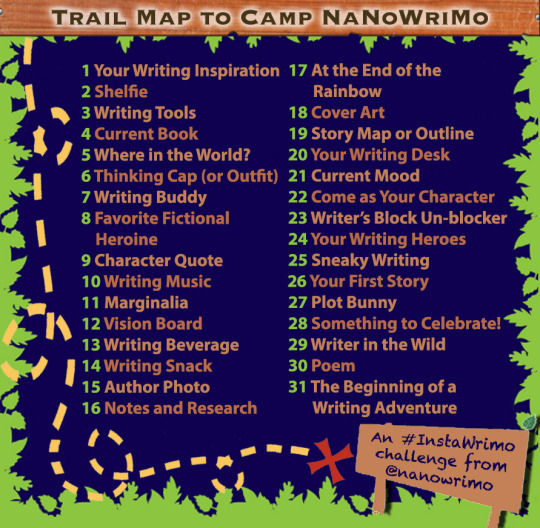 The month of March is almost upon us, which means that Camp NaNoWriMo will be here soon!
The month of March is almost upon us, which means that Camp NaNoWriMo will be here soon! If you’ve never participated in Camp before, it’s an online writing retreat that we run every April and July. It’s kind of like November’s rebellious little sister: you can set your own goal, work on any kind of writing project (it doesn’t have to be a novel), and join a cabin to chat and write with other Wrimos.
This March, we’d like to get the awesome NaNoWriMo community excited about Camp by taking part in a month-long Instagram challenge hosted by us. All you need to join in is an Instagram account.
Follow @NaNoWriMo on Instagram.They say a picture is worth a thousand words (and you know we’re always keeping an eye on that word count), so we’ve come up with 31 photo prompts listed in the graphic above to get you thinking about your writing habits and the tools in your creative backpack for the month of March. We’ll post the full challenge prompt on Instagram, but it will also be available in this post if you need to refer back to it.
Much like Camp NaNoWriMo itself, there aren’t any strict rules. These prompts are just suggestions—you don’t have to be literal, though if you want to take these prompts very literally, that can result in some fun pictures, too. You can post a photo for each of the prompts, or choose just a few. You can post one every day, or all at once. Again, much like Camp, the most important part is having fun.
Make sure to tag any posts with the #InstaWrimo hashtag so we can find them! We’ll pick photos from the challenge to feature on our own Instagram account throughout the month. This will be a fun way to think about your writing projects and get back into the swing of things: Where do you like to write? Who do you like to write with? What makes you happy about your writing?
Use your imagination, get creative, and get ready to write! (Image text detailed below)
IMG: A graphic labeled “Trail Map to Camp NaNoWriMo: an #InstaWrimo challenge from @nanowrimo”, and featuring the following prompts:
Your Writing InspirationShelfieWriting ToolsCurrent BookWhere in the World?Thinking Cap (or Outfit)Writing BuddyFavorite Fictional HeroineCharacter QuoteWriting MusicMarginaliaVision BoardWriting BeverageWriting SnackAuthor PhotoNotes and ResearchAt the End of the RainbowCover ArtStory Map or OutlineYour Writing DeskCurrent MoodCome as Your CharacterWriter’s Block Un-blockerYour Writing HeroesSneaky WritingYour First StoryPlot BunnySomething to Celebrate!Writer in the WildPoemThe Beginning of a Writing AdventureFebruary 25, 2019
6 Writing Insights I Learned From My 9-Year-Old Writing Partner
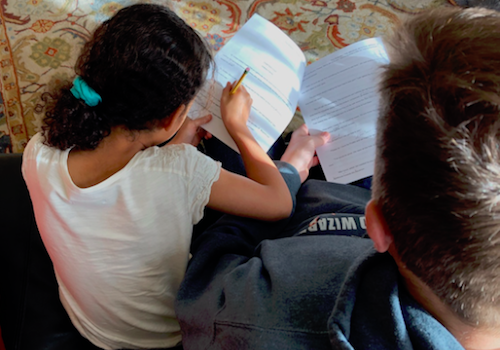
Many authors think of writing as a solitary activity. But sometimes, it can be fun to collaborate with a partner! Today, author and editor Jarie Bolander shares how he dove into children’s fiction by collaborating with Reeva, his young co-writer (pictured above):
I was never an avid reader as a kid. My usual reading material consisted of Popular Science, old textbooks, and the occasional Mack Bolan series. Even to this day, I mostly read and write nonfiction.
My interest in fiction grew out of NaNoWriMo and StoryGrid. It’s been a fantastic adventure to do a deep dive into the fiction pool to see how story shapes our lives. The motivation to actually write a chapter book came from my girlfriend’s daughter, Reeva, who one day said “You write. Why not write a book for kids like me?” Thus started our adventure into writing The Magical Mystical Mirror.
For most of us, writing is a solo activity. We labor away at our keyboards spinning worlds and crafting tales that are interesting to us. It’s only when we’re done with the first draft that we might hand it off to an editor.
The process of writing with Reeva has given me some valuable insights that have made me a better writer. I would have never learned them if I had not opened my mind to different perspectives.
1. Agree on the genre.Genre can be tricky for a chapter book. Most of the ones Reeva reads are mysteries so we decided to go that route.
2. Decide on the theme.Once we figured out we wanted to write a mystery, we had to figure out the theme. Reeva likes visiting aquariums because she loves animals. We wanted her love of animals to be part of the theme, which is:
3. Use a common language.The repercussions of the past come to life as a single mother of two seeks to save an endangered species by traveling back in time—The Magical Mystical Mirror.
One of the challenges we faced was how to communicate about what we wanted to write. We needed to come up with a common language—which for us, was via examples of stories she was reading.
4. Get agreement, then stay focused.Several times through our writing process, we would get distracted. This usually manifested itself in creating more characters or completely different plot lines. Thankfully, we would resolve this by simply committing to focusing on writing the idea we had. We could always change it later.
5. Write for your target audience.I normally don’t write fiction, and the nonfiction I do write is usually targeted to the entrepreneur crowd. The Magical Mystical Mirror is a different audience that’s not going to understand subtly or nuance. What might seem obvious to me won’t for a 9-year-old. This was important since my job was to do most of the writing, and without Reeva telling me what she thought, the book would not hit the mark.
6. Bring the story to life.As writers, it’s sometimes hard to picture a place or a scene in our heads, especially if you’re writing outside your comfort zone. That’s why we took two field trips to Monterey (where our story is set) to feel what it likes to walk the streets. This was not only inspiring but also made the experience fun for all of us.
Outside My Comfort ZonePart of the reason that NaNoWriMo is such an enjoyable experience for me is the community that it creates. I would never have thought to write a chapter book, let alone with a writing partner. This experience has made me a better writer and made me want to write more stories outside my comfort zone—something we should all try and do.

Jarie Bolander is an engineer by training and an entrepreneur by nature. He has over 20 years of experience bring innovative products to market. He is a Certified Story Grid Editor who uses his training to help his companies tell better stories. He has published six books—8 Startup Dilemmas All Founders Will Face, The Entrepreneur Ethos, 7 PR Secrets All Founders Should Know, #Endurance Tweet, Frustration Free Technical Management, and Business Basics for Entrepreneurs. He’s on Twitter @TheDailyMBA.
February 22, 2019
Meet Our New NaNo Intern, Nina!
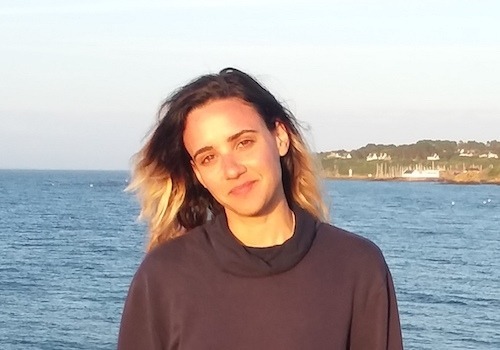
We feel super lucky here at NaNo HQ to be able to work with some excellent interns! Today, meet
Editorial Intern Nina Sacco, the newest addition
to our team:
Hey, writers! I am so excited to be a NaNoWriMo Intern this spring! I’m grateful to have the opportunity to be part of a community that supports accessibility in literature. After all, we all have a story to tell. And where would we be if we didn’t learn how to listen to one another?
I’m no Freud or anything, but I suspect my love of words and stories was first ignited as a small child. My mom always made time to read to us before bed. I loved listening to her voice paint moving pictures in my head. Honestly, “reality” has never made all that much sense to me. Growing up, I found more truth in works of fiction than I ever could in a high school history book. Which only drove me deeper into the Land of Make Believe. I’ve been scribbling in notebooks and/or on napkins ever since I learned my ABC’s.
I’m a big fan of dogs, ponies, trees, the ocean, film noir, traveling, reading, and writing (obviously). When experiencing writer’s block while hacking away at my own first attempt at a novel, I have been known to retype my favorite novels—such as Ask the Dust, If Beale Street Could Talk, and Catcher in the Rye—word for word on my cherry red ‘63 Olivetti Lettera. Nerd Alert.
My hope is to learn as much as I can working with NanoWriMo this spring, and that ultimately I, too, will find the inspiration and dedication to become a NaNoWriMo winner this November!
February 20, 2019
The Second Time’s the Charm

During the NaNoWriMo Now What? Months, we’re focused on helping you revise, edit, and publish your story. Today, writer Melanie Marie Martinez shares some editing advice on how to get to your second draft:
You are never the same person twice.
My grandfather told me this once, and I’ve taken it as something of a life motto. Who I am today is smarter, older, and wiser than who I was yesterday. That means that no matter how good or bad the words are today, they will always be better, or at least different, tomorrow. This is why revision is so important.
Here are some tips for writers who, like me, find it hard to revisit that initial draft:
1. Don’t throw out your entire first draft.When it comes to writing and editing, people often say not to worry about your first draft because it’ll always be terrible. I’ve found that to be unfair. Sure, at 3 AM you might have difficulty stringing a sentence together with your daily word limit just out of your reach, but sometimes that pressure gives you diamonds—revelations you might have not come across if you were too busy overthinking!
There should be a healthy middle ground. Don’t throw it all away, but don’t treat it like it emerged from your brain fully formed and ready for publication. A second draft lets you sift out the diamonds from the coal and gives you chance to polish them.
2. Bite off only as much as you can chew.Looking back at how much blood, sweat, and tears went into that first draft, you might suffer a bit of post-trauma at the thought of going back into the trenches again. Set up a daily and monthly revision schedule, whether that’s a chapter a day, an hour a day, or a thousand words a day. Go big or small, but be realistic to what you feel comfortable doing.
Give yourself benchmarks for the rest of the year, and cut yourself slack if the standards turn out to be too high. Revisit the schedule, revise, and keep on trucking! As long as you don’t stop, you haven’t lost.
3. If all else fails, phone a friend.The moment you hand your writing off to someone else, it becomes a thing of its own. Though many writers are private people, a middleman can often help. If you struggle with doing a second draft yourself, hand it off to someone you trust and have them run a “sanity check.” A bare bones assessment from a close friend or longtime writing partner can wipe away some of the fog from your nostalgia goggles and give you a better idea of where to start tightening up draft two.
The truth of the matter is this: it is easier to keep starting over than wade through the brackish waters of that dreaded first draft. But it is also true that, day by day, we are constantly moving towards our best selves. Likewise, with every passing draft, your novel will become the best version of itself.

Melanie Marie Martinez is a graduate of the Long Island University Creative Writing MFA. Since she was thirteen years old, she’s been writing fiction, poetry, and comic book scripts. When she’s not working on the Great American Novel, she tutors English and Creative Writing, teaches a Blogging for Business seminar, and helps write university-level degree programs. She was born in the swamps of South Florida and currently stalks the jungles of New York City. She can be reached at www.martinezmariemelanie.com.
Top photo by Patrick Tomasso on Unsplash.
February 18, 2019
How to Tackle NaNoWriMo With Clinical Depression

One of the most important things to keep in mind when you’re writing is making sure that finishing your project doesn’t adversely affect your mental health. Today, writer Andrea Tomé shares how she balances writing and mental health needs:
There’s this trope in which writers almost always have a mental disorder that always grants them WRITING SUPERPOWERS. They’re able to finish a whole draft in two days, providing they have enough cheese balls and Coke cans on their desk (think Johnny Depp in Secret Window).
For some authors, writing is therapeutic. Me? My depression is so linked to my perfectionism that every time I struggle with my writing, I’m paralyzed. The white page is enormous, and it blinds me; writing a sentence requires Herculean strength.
I entered November feeling at my lowest, but I wanted to win NaNoWriMo. I was sure that my depression would always be this massive rock in my way unless I started learning to work in spite of it.
November was the most depressed I had been, but with a little help from my friends (is The Beatles song playing in your head right now?) I was able to complete the 50k words.
How? There are certain coping mechanisms that always help. Maybe you won’t write 50k in a month, maybe you’ll still struggle to find motivation, but what’s most important is to shift your focus: you’re struggling with a cruel disorder and you’re creating something beautiful nonetheless. That’s heroic.
These are my five tips on how to tackle NaNoWriMo when you’re dealing with depression:
1. Cut yourself some slack.Aim for the 50k, but make sure you’ll be okay if you don’t reach that word count. Think of NaNoWriMo as an opportunity to finish a first draft that’s probably gonna be terrible because that’s the nature of all first drafts.
2. Step out of your comfort zone.You hate this expression. I know you hate this expression. Everyone hates this expression. But hear me out: old methods will only bring old results (you hate this expression too). For me, stepping out of my comfort zone meant being less of a writing hermit and participating more in local write-ins (you can organize some with your friends if you don’t have any “official” ones in your hometown).
3. Plan your writing sessions AND your rests.Lack of motivation is a struggle when you have depression, so take a minute to consider your schedule and plan your writing sessions around it. What about resting? Plan it too, and be as specific as possible. Think about some self-care activities you will feel genuinely excited about: it can be meeting with a friend, or doing a Korean facemask while you listen to your favorite podcast, or maybe binge-watching that Netflix show that has been on your to-watch list since forever.
4. Don’t forget to socialize.One of my favorite memories of high-school were the café study sessions with my best friends in which, quite honestly, we didn’t do as much studying as we had hoped for. It’s okay. The goal isn’t to be 100% productive at the expense of your mental health; the goal is to be as productive as you can while taking care of yourself. Meeting with people is hard when you have depression, but finding a writing buddy (or a friend who will work on something else while you write) will make everything easier.
5. Listen to your body (another expression you hate).During NaNo I took a whole week off because I was feeling mentally drained— and my novel turned out okay. If you’re feeling burnt out, take days off and tackle your project with energy to write double the time the following days. Work smarter, not harder.
Writing is hard. Writing when you have a mood disorder is harder. You’re an absolute superhero just for trying, don’t forget it.

Andrea Tomé was born in the Fall of 1994 in the North-West of Spain. She published her first novel, Corazón de mariposa, when she was 19 and hasn’t stopped writing and publishing since.
She lives in London, where she works in the publishing industry and goes to the Tate Modern way too often. She’s also guest author for The Mighty and Sick Not Weak and she occasionally gives public speaking gigs on mental health. 2018 was her fifth time participating in NaNo and the second time she won.
Top photo by Kelly Sikkema on Unsplash.
February 15, 2019
What It’s Like to Publish Your Book With a Small Press

If you’re looking to publish your novel, the options can feel overwhelming. From the Big 5 to self-publishing, where to start? Today, author Victoria Sheridan is here to share some experiences with small press publishing, which is somewhere in the middle:
Your novel is written, edited, polished, and ready for publishing. But how to go about that crucial last step? Some authors choose to go traditional by querying agents and hopefully signing with a major publishing house with lots of marketing opportunities, while others choose to self publish, preferring to have personal control of every step of the process. There is, however, a middle ground: small presses.
Small presses are what they sound like—a publisher that offers all or almost all of what a traditional publisher offers, including editing, cover design, and marketing, but on a much smaller scale. This can make them much more nimble and willing to take chances, and oftentimes they interact directly with the author, no agent needed. Many small presses have a specific special interest, which is great news for people who write genre fiction.
I chose a small press almost accidentally. I had a new manuscript, but no real idea what to do with it. It was very niche—a historical mystery with LGTBQ characters—which would be an unusual choice for a traditional publisher. But I didn’t want to self-publish—I simply did not have the background or the time to teach myself all the complex aspects. However, I knew about small presses, particularly small presses that focused on queer characters like NineStar Press and Harmony Ink. So I posted in PitMad (a Twitter pitch event) and waited.
To my delight, both a large press and a small press made inquiries, so I sent over manuscripts. The small press got back to me within three weeks with a personal email from the person to become my editor, followed shortly by congratulations and next steps from the director herself.
“My personal favorite thing about working with a small press is the community with fellow authors.”It’s the personal and close moments like that that make working with a small press so delightful. Everyone is passionate about books, especially their books—they only put out a few, so they treat every book as lovingly as its author. Someone is there to edit with you, sort through the legal bits, and start you on your marketing journey. Have a question about your process or your rights? The answer is just an email away. Not thrilled with the cover design? They’ll work with you until everyone is happy. But my personal favorite thing about working with a small press is the community with fellow authors. Writers, in case you didn’t notice by now, flock together, and with a small press there are enough that we can all support one another, but not so many that it feels overwhelming.
Small presses might not be for everyone, but they can be a great place to find the support you need, both for morale and the publishing process itself. They’re in your corner helping you make your book the best it can be with all the care of a friend. And they’re as excited as you are to make your publishing dream a reality.

Victoria is a terribly boring office worker from New Jersey. She studied archaeology, anthropology, history, architecture, and public policy, but none of those panned out, so she decided to go back to an early love—writing. She proudly publishes under Thea McAlistair with NineStar Press, a small press dedicated to LGTBQ+ works. The first draft of her debut novel No Good Men was a product of NaNoWriMo 2014 and comes out in May 2019.
Top photo by Bruno Martins on Unsplash.
February 13, 2019
How to Write Your Rough Draft 2.0

During the NaNoWriMo Now What? Months, we’re focused on helping you revise, edit, and publish your story. Today, NaNoWriMo participant Osie Cairn shares some editing advice on updating your messy first draft to version 2.0:
Writing that initial rough draft for me is a lot like careening around corners and sitting in the backseat while my sister’s learning how to drive: Absolutely terrifying. Sure, you can let your Inner Editor out while writing, but you’re probably not going to get much done—just like your sister isn’t going to get better if you kick her out of the driver’s seat to drive to the store yourself.
But after that journey is done? When you’ve written “The End” on your rough draft and know every mile of the journey your characters take? That’s when your editor gets to take control. That’s my favorite part of writing.
Editing is where you already know the story, who the characters are, what the plot is, and so don’t have to worry about what’s going to come out when you type. You don’t have to slog through a scene wondering where you’re going or if it’s going to be relevant once you reach the end. Because you already know. It’s all written down.
It’s where you get to take the mess of a rough draft and turn it into a shiny new Rough Draft 2.0.
Sure, it can be super intimidating to know where to start when you look at the mess before you, to wonder how you’re going to fix everything that’s wrong with it, but hey, you’ve already written that rough draft! You’ve already done the hard work. You kicked your editor to the back seat so your creativity could take the wheel and get you to where you needed.
Now, you get to jump into the driver’s seat (and take control of the radio).
On this part of the journey, the biggest thing to keep in mind is this:
Editing is just like writing that initial draft, but this time you know what you’re doing.I keep notes about what I want to fix or tweak while I’m writing the initial rough draft so I know what to work on when I get around to editing. If you haven’t done that or don’t have a general idea of the big things you want to work on, writing up a list can be a good first step. It’ll get you thinking critically about your story and focus your attention on the areas that need it.
If you already know what needs fixing and you’re at that “Ok, but how do I actually fix it?” stage, then it’s time to turn your initial rough draft into Rough Draft 2.0 with three simple steps.
Open up your rough draft.Open up a blank page on your favorite word processor, notebook, or typewriter. Rewrite everything from word one.Just like you wrote your rough draft one word, sentence, and paragraph at a time, you’re going to write your Rough Draft 2.0 the same way. But, this time you already know what’s at the end, what scenes are relevant, what details need to be cut or included, what lines are in character or not. You get to write the story and know where you’re going.
All of the changes you make, they’re going to cause changes later down the road. New plot holes might pop up and old ones might disappear. Old scenes you thought needed a complete rewrite might be cut completely, or a detour might bring the perfect opportunity to resolve multiple points at once.
That’s just part of the process.
Fix what you can on this draft, and let the rest wait for a later pass.
Writing the rough draft might be like watching your sister learn to drive, but editing is a road trip where Rough Draft 2.0 is only one stop.
Osie Cairn is a multiply disabled queer author who hates making eye contact. They also beta read and edit others’ work when their own writing doesn’t provide them enough material to satisfy the red pen. In addition to thinking editing is the best part of writing, they have special interests in space, science, stars, and sharks. Oh, and dinosaurs, but those don’t start with an S.
Top photo by Samuele Errico Piccarini on Unsplash.
February 11, 2019
5 Tips From a Graphic Designer on Creating an Impactful Book Cover

During the second month of our “Now What?” Months, we’re focusing more on publishing in all its myriad forms. Today, graphic designer Charlene Maguire shares some pro tips on how to choose a cover that really pops for your novel
:
“Why is a book cover design so important?” you might ask. Well, we all judge a book by its cover. A book cover has a visual language all its own through the use of typography, imagery, color, and emotional impact.
Your book is a little package of experiences, put together for your reader to enjoy. This package needs a sign outside to tell people what is potentially inside for them… a mystery to solve? A romance to swoon over? A drama, biography, or travel adventure? A fantastic cover speaks to the fans of a genre and tells them something about what they’re going to get.
Your cover is your book’s first impression to your potential reader. In today’s crowded marketplace of limited attention spans, a person will decide if they are interested in your book in a matter of seconds.
1. Do your homework.You have to do some research. This is the key to understanding both what you might want for your cover as well as what appeals to readers. Go browse in a bookstore and scroll online. Choose some covers that inspire you.
Pro Tip: When browsing online, a cover has to be impactful both when you’re looking at it full size and as a small thumbnail. Online retailers will usually display your cover at varying image sizes, so know that it has to be clear and readable at different pixel resolutions.
2. Typefaces have personalities.Choosing typefaces is an art all its own. Pay attention to those covers that inspired you from browsing bookstores. What kind of feeling do you get from looking at the typefaces used for the title and author?
Pro Tip: Whatever is decided on for typefaces, it needs to be readable!
3. Color is important.The dominant colors in a cover can influence mood and play a large role in creating the contrast necessary to draw attention to your book. For a thriller/crime novel, Dark colors like black/navy blue give a sense of suspense and seriousness. For a heartfelt memoir, pale or pastel colors will convey a softer, more delicate feel. Is there a strong hero in your story? Bright contrasting colors will create a powerful stance.
Pro Tip: Complementary colors are those found opposite one another on the color wheel, and create a strong energy when used together. Analogous colors are those found next to one another on the color wheel, and give a more harmonic feeling when used together.
4. Emotional impact.We’ve talked about typefaces and color. When using imagery (photography or illustration) for a cover, you want it to speak simply and clearly. An image is a big part of your visual story.
Pro Tip: Characters, objects, and scenes in the book do not need to look *exactly* as they are described for a cover. Sometimes that can work, but most of the time a hint of something close that draws your eye in is best.
5. Your cover is not about you.Your cover is for your readers. What is the driving message of your book? what do you want people to know that will pique their interest? Put yourself in your readers shoes. Start the visual story there.
Pro Tip: When choosing to work with a designer for your cover, all points mentioned here reflect questions that will be asked by a designer. Send us what your story is about, examples of covers, and other preferences and specifications. From there a designer will use their creative expertise to give your book the best cover possible.

Charlene Maguire is an award winning artist, designer, and author. When she’s not creating stunning graphics for others with her 20+ years experience in the business, she’s working on her own product creations. Her oracle card deck “The Language of Heart Alchemy” was self-published in 2016, and she is currently constructing two other card decks. The writing bug has bit her hard as well, and a first novel is being written as we speak. Find her online at www.kissthesuncreative.com
Top photo licensed under Creative Commons from David Marriott, Jr. on Flickr.
February 8, 2019
How to Research the Agent That’s Best for You

So you have your NaNo novel in hand, and you feel ready to publish. But before your book makes it to shelves, it has to change hands—from writer to agent to editor and publisher! Today, author and entrepreneur Jane Friedman shares her advice on how to track down the agent that’s best for your book:
If you want to be published by one of the big New York houses—such as Harpercollins or Penguin Random House—then you’ll quickly discover that they don’t accept material directly from writers. Instead, you have to find an agent to submit on your behalf.
Fortunately, finding an agent is more about doing research and pitching appropriately and not about having an inside connection. You need to answer three questions as you search:
Is this agent actively considering new work? Do I think this agent is a good fit for my work? What materials does the agent require for my work to be considered?I recommend you take a methodical approach to the research and submissions process to ensure that you give your work the best possible chance. Here’s the big-picture overview:
Begin with online databases or print market guides that list hundreds of agents. Develop a broad hit list that includes every potential agency you might approach.Next, dig deeper into each potential agent by doing online research. You’re looking for any information that might help you understand what submissions they want to see from writers.
Then start to categorize the agents according to fit: “my dream,” “good fit,” “maybe.”
You’ll be gathering lots of information, so use your favorite note-taking tool or software. I like Evernote. Other writers use Microsoft Excel. What’s important is that you log the information so that you can easily find it later. You can use this same document to track your submissions process.
Major Databases for Researching AgentsSome of the following resources are free. Others require you to pay a subscription fee. As you might expect, the fee-based services typically offer higher-quality information, and your research process would likely be incomplete without investing in one.
WritersMarket.com. You can pay a monthly or annual fee to access its database, or look for the annual print edition at a library or bookstore. PublishersMarketplace.com . I consider this the best place to research literary agents; many agents have member pages at this site with helpful submissions information. A paid subscription is required, $25/month. AgentQuery.com . Free site offering about a thousand agent listings and an excellent community for writers going through the query process. QueryTracker.net . The basic service is free. Mswishlist.com . A site that aggregates tweets from agents and editors about what they’re currently looking for. “MS” stands for “manuscript.”Databases include information about what types of work are accepted; what submission materials to send and when; specific tips from the agents being listed; and more. Publishers Marketplace, though expensive, can be particularly insightful since it gives you access to book deals that have been made recently (as well as going back to 2000). For each book deal listed in its database, you’ll find the following information:
the author and title of the book, along with a one-sentence descriptionthe agent who represented the bookthe editor and publisher who bought the bookYou can search the deals database based on your own book’s category or genre, and can narrow your search further by using keywords. While it’s far from a complete listing of publishing deals, Publishers Marketplace quickly gives you sharp insight into who’s buying what, and what agents are actively selling.
Once you’re armed with your list of agents or publishers, undertake a more in-depth investigation of each.
First, visit their websites, where you’ll typically find the most up-to-date information, including whether they’re open for submissions. For literary agencies, read the descriptions of all member agents and determine which one is the best match. Some agents have active blogs or news and events pages, which can be useful to scan.
After studying the website, move on to social media. Twitter is popular in the publishing community, so you’ll likely find a presence there. Many agents use social media to have conversations with authors, potential authors, and other industry insiders. Studying these communications not only provides insights into the submissions process but helps you ascertain fit. Is this someone you want to do business with? Do you like their demeanor? What gets them enthusiastic?
Other Methods of Researching Agents and PublishersOne of the oldest recommended methods of finding an agent is to look in the acknowledgments section of a book you’ve read that’s similar to your own. Just about every author thanks both their agent and their editor.
Another tried-and-true method is to ask published friends—if you have any—for a referral to their agent. The danger is that your author friend might not believe your book is all that good! So it can be a delicate situation.
If you’re willing to work with a new and “hungry” agent, then keep a close eye on new market announcements. You can find them reported at Publishers Marketplace, which you can access if you’re a subscriber; Writer’s Digest’s Guide to Literary Agents blog, which posts about new agents; and online writing communities that have dedicated threads for such announcements. Also, every year, Writer’s Digest publishes a special agent issue in October, highlighting twenty or more agents who are seeking new clients.

Jane Friedman is a full-time entrepreneur and has 20 years of experience in the publishing industry. She is the author of The Business of Being a Writer, which received a starred review from Library Journal and is considered an essential reference for writers. Learn more at JaneFriedman.com
February 6, 2019
How to Create the Perfect Story Arc
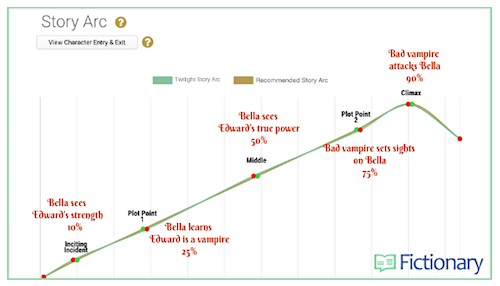
Every year, we’re lucky to have great sponsors for our nonprofit events. Today, our sponsor Fictionary has put together a step-by-step guide for creating the perfect story arc:
One of the best ways to improve your novel is to look at the way that successful authors have crafted their story arcs. You can use this information to revise your NaNoWriMo novel and tell a story your readers love.
Spoiler alert! We’re about to delve into Stephenie Meyer’s blockbuster novel Twilight while paying attention to the plot points that keep the story moving.
You may be familiar with the simplest form of a story arc:
The inciting incident is the moment the protagonist’s world changes in a dramatic way. Readers expect something to trigger the protagonist to act. If the inciting incident doesn’t occur in the first 15% of your novel, you need a strong reason for delaying it.
I recommend that you write your inciting incident as a dramatic scene and not as backstory or narrative summary. This enables the reader to experience the event at the same time as the protagonist and increases your chances of getting the reader emotionally involved.
Twilight’s Inciting Incident: Bella has already met Edward. This leads up to the inciting incident where Edward saves Bella from being killed in a parking lot. She gets her first glimpse of his powers and is set on her path of discovering more about him.
Twilight’s Inciting Incident happens 10% into the story. The percentage is based on the word count.
2. Plot Point OnePlot Point One is the point of no return—your character can’t back out of the central conflict. Your character may be obligated to take action, they cannot return to the way the world was before, or their desire for something overrules all else. There must be something at stake, because if the character doesn’t care about the outcome, a reader won’t care either.
Plot Point One should occur between 20% and 30% in your novel. If this plot point comes too late, the story will feel like it’s dragging. If it comes too early, the story will feel rushed or lacking in depth.
Twilight’s Plot Point One: Bella suspects that Edward is a vampire, but she decides to pursue him anyway. Edward has emotional power over Bella.
Twilight’s Plot Point One happens 25% into the story.
3. The MidpointOften the Midpoint is where an author struggles to keep the story interesting. To keep your story exciting, you’ll need to find some way to raise the stakes of your story with a life-changing, exceptional, or threatening event.
Ideally, this is where you’ll be taking your readers on a journey where the protagonist moves from a reactionary mode to a proactive mode.The Midpoint should occur between 45% and 55% in your novel. If the Midpoint comes too early or too late, the story won’t feel balanced.
Twilight’s Midpoint: Edward reveals his true powers as a vampire to Bella. He saves her from an attack, and this strengthens how she feels about him.
By now it should be no surprise that Twilight’s midpoint happens at 50% of the story.
4. Plot Point TwoAt Plot Point Two, the protagonist must work hard to get what they want or lose everything. Plot Point Two should occur between 70% and 80% of your novel.
Plot Point Two will be a low point for your protagonist. Their actions since the middle have caused disaster, or they become more determined to reach their goal.
Twilight’s Plot Point Two: A bad vampire decides to go after Bella, and Bella must leave her home. Bella wants to survive but not if it means risking those she loves.
Twilight’s Plot Point Two happens 75% into the story.
5. The ClimaxThe Climax scene is where you get to shine as an author. Every word you’ve written up to this point will pay off. Ideally, the climax scene (or scenes) will have the highest level of conflict, the greatest tension, or the most devastating emotional upheaval.The protagonist must be in your Climax scene, or you risk alienating your reader. The protagonist should face the biggest obstacle in the story and determine their own fate.
The climax should happen somewhere around 90% into your novel. Too early, and the reader may get impatient with a long resolution and skim to the end. Too late, and the resolution may lack depth or satisfaction.
Twilight’s Climax: Bella is lured into a trap. She faces down the evil vampire and gets injured.
And you guessed it. Twilight’s Climax happens 90% into the story.
6. The ResolutionThe resolution is everything that happens after the climax. It shouldn’t be longer than 10% of your total story. This is the time to give the reader an emotional resolution as well as tie up any loose ends.
Twilight’s Resolution: Bella and Edward are home, safe, and together, but when Bella tries to persuade Edward to turn her into a vampire, this leaves the reader questioning what happens next.
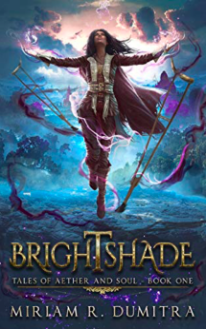 Fictionary Author Hits #1 on Amazon
Fictionary Author Hits #1 on AmazonLast year, Miriam R. Dumitra won the Fictionary Finish Your Novel contest and received a lifetime subscription to Fictionary.
She put Fictionary to great use and her debut novel Brightshade recently hit #1 on Amazon in the category of Steampunk Science Fiction.
Miriam was also a 2018 NaNoWriMo winner, so there’s another book coming. Congratulations Miriam!
How Fictionary HelpsEditing is hard. Fictionary makes it easier with online software that simplifies and automates story editing. Use Fictionary to improve the structure, characters, plot, and settings of your NaNoWriMo novel.
A perfect tool to help complete your revision pledge. Within seconds, Fictionary automatically creates your cast of characters, links characters to scenes, calculates word count per scene, draws your story arc, and then guides you through a complete scene-by-scene revision.
Fictionary “Now What?” 50% Discount OfferSign Up for Fictionary using coupon code NOWWHAT2019 and get Fictionary for just $10/month.
No credit card required. Try free for 14 days and cancel anytime. Includes our 13-lesson story editing course delivered to your inbox. Signup required by March 31st, 2019 to lock in the 50% discount for 3 months.

Kristina Stanley is an editor, author, and CEO of Fictionary. She’s the best-selling author of the Stone Mountain Mystery Series, Look The Other Way, and The Author’s Guide to Selling Books To Non-Bookstores. Her short stories are published in Ellery Queen Mystery Magazine and Voices from the Valley anthology. She won the Audrey Jessup Capital Crime Writing award and her work was shortlisted for the Crime Writers of Canada Unhanged Arthur and the Crime Writers’ Association Debut Dagger.
Chris Baty's Blog
- Chris Baty's profile
- 63 followers



